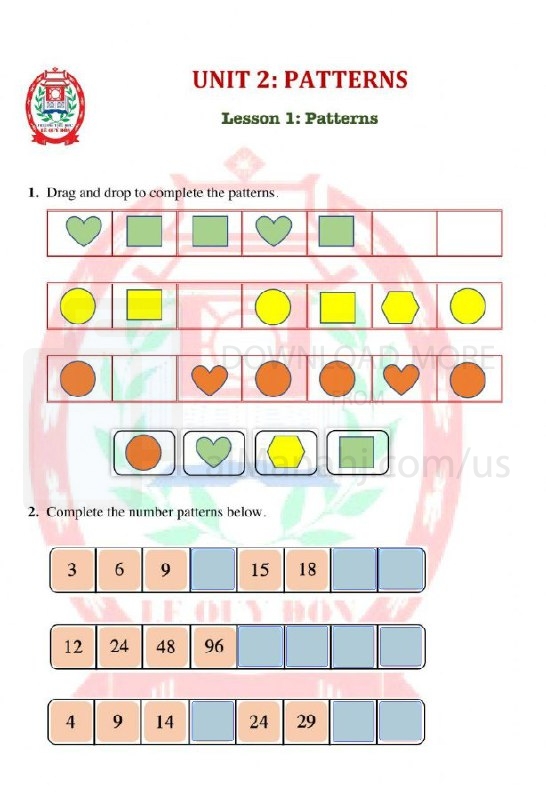File info: A worksheet about completing patterns in math is an educational resource designed to help students practice and develop their skills in identifying and extending patterns. The worksheet typically includes a series of pattern sequences that require students to analyze the given pattern and fill in the missing elements. It aims to improve students' pattern recognition abilities, logical thinking, and understanding of number relationships. Here's a description of what a worksheet about completing patterns in math might include:
1. Introduction: The worksheet begins with an introduction that explains the purpose and focus of the worksheet. It may provide a brief overview of patterns and their significance in mathematics and real-life contexts.
2. Pattern Sequences: The worksheet presents a series of pattern sequences that follow specific rules or relationships. These patterns can involve numbers, shapes, colors, or other elements. Each pattern sequence is presented partially, with some elements missing, and students are tasked with completing the pattern by identifying and writing the missing elements.
3. Pattern Recognition: The worksheet emphasizes the importance of recognizing patterns and identifying the underlying rule or relationship within each sequence. It may provide examples and explanations of common types of patterns, such as arithmetic sequences (e.g., adding or subtracting a constant value), geometric sequences (e.g., multiplying or dividing by a constant ratio), or pattern sequences based on alternate or repeating patterns.
4. Extending Patterns: The worksheet challenges students to extend the given patterns by predicting and writing the subsequent elements. This requires them to apply their understanding of the pattern rule and continue the sequence accordingly. The extension of patterns may involve increasing or decreasing numbers, repeating patterns, or more complex relationships.
5. Different Types of Patterns: The worksheet may include a variety of pattern types to expose students to different patterns and enhance their pattern recognition skills. This can include number patterns, shape patterns, letter patterns, or a combination of multiple types. The different pattern types help students develop a broader understanding of patterns and their applications.
6. Problem-Solving Strategies: The worksheet may provide problem-solving strategies or tips to guide students in analyzing and completing the patterns effectively. These strategies can include looking for similarities and differences between elements, examining the position or order of elements, considering the relationship between consecutive elements, or applying known mathematical concepts or operations.
7. Practice Exercises: The worksheet includes practice exercises that allow students to apply their pattern recognition skills independently. These exercises may involve completing multiple pattern sequences, each with varying levels of complexity. The practice exercises provide ample opportunities for students to reinforce their understanding and develop proficiency in completing patterns.
8. Visual Representations: The worksheet may incorporate visual representations, such as diagrams or images, to help students visualize and understand the patterns more effectively. Visual aids can enhance students' pattern recognition abilities and make the learning experience more engaging.
9. Answer Key: The worksheet includes an answer key that provides the correct solutions or completed patterns. This allows students to check their work, verify their answers, and self-assess their understanding and progress.
The purpose of the worksheet about completing patterns in math is to help students develop their pattern recognition skills, logical thinking, and understanding of number relationships. |
